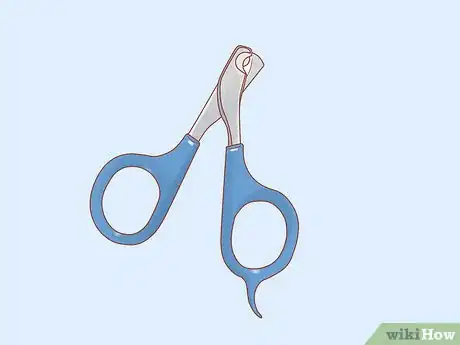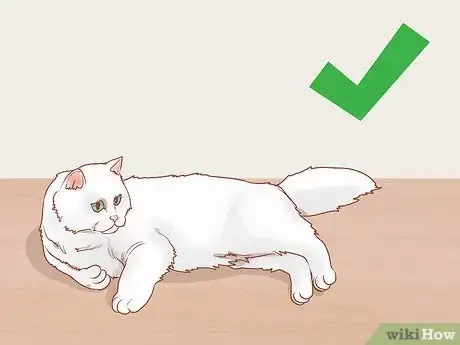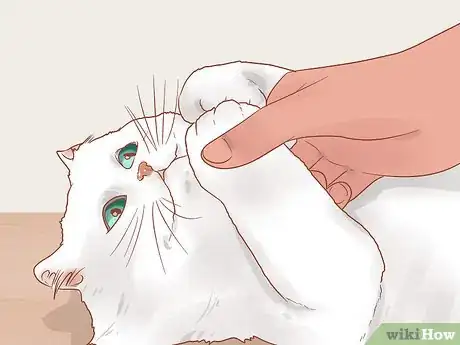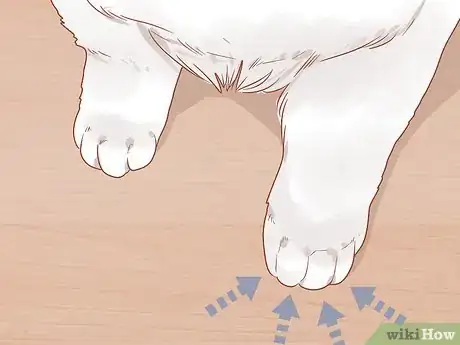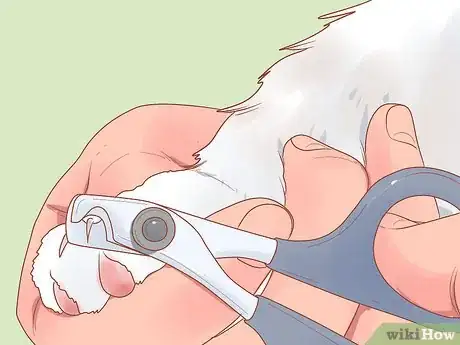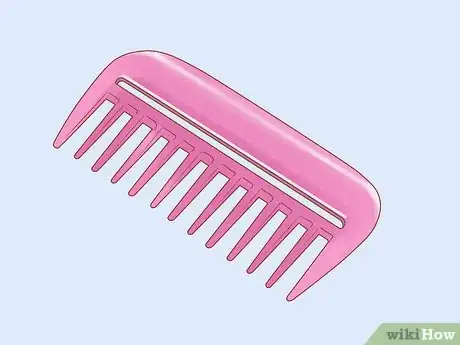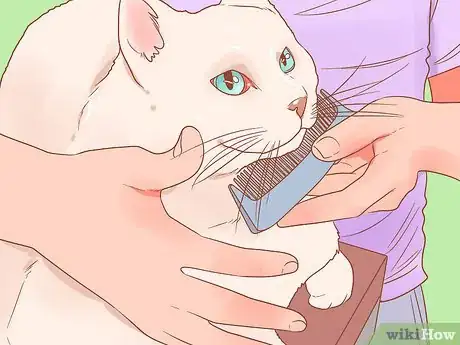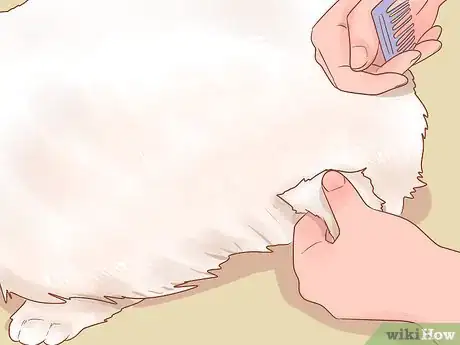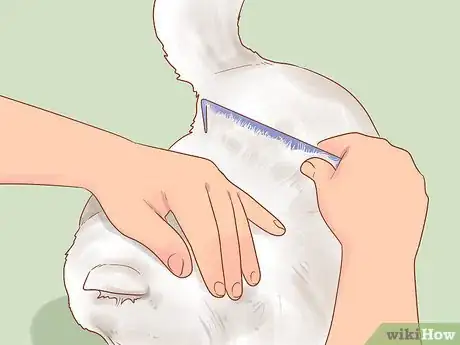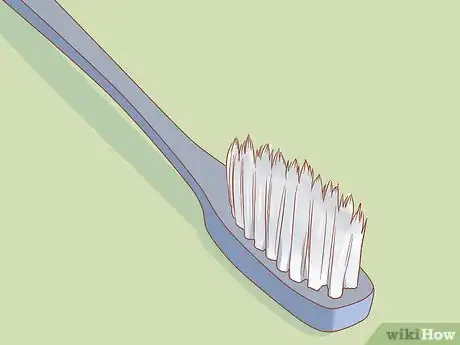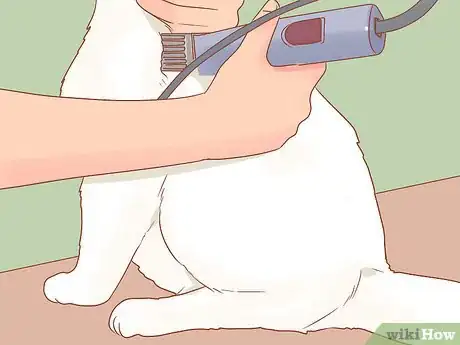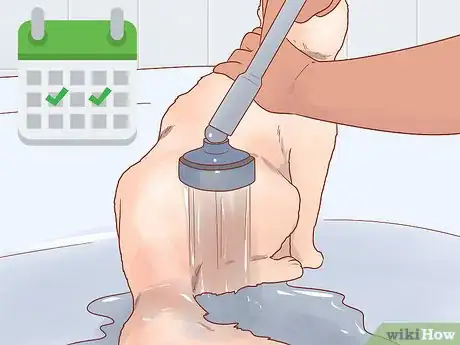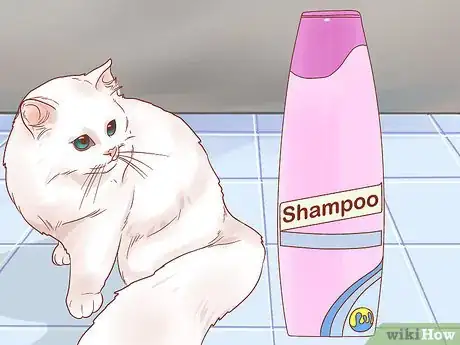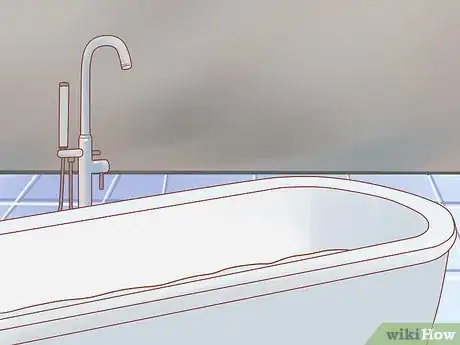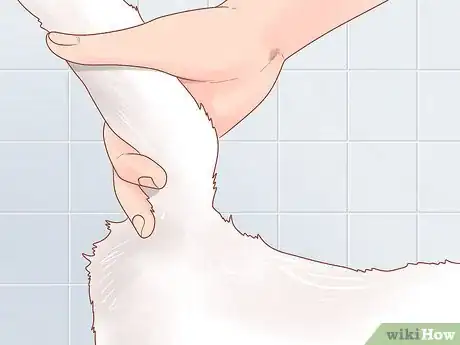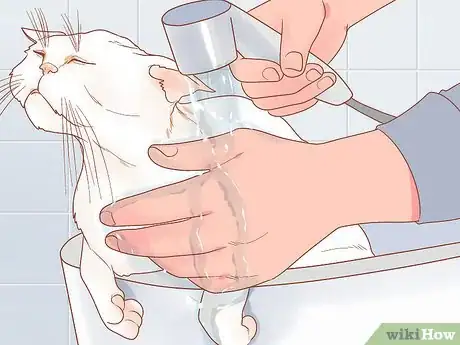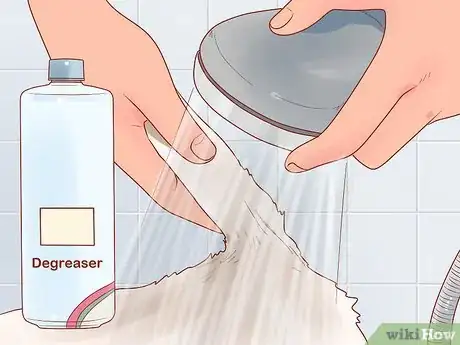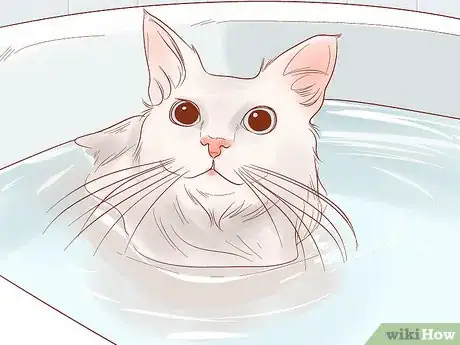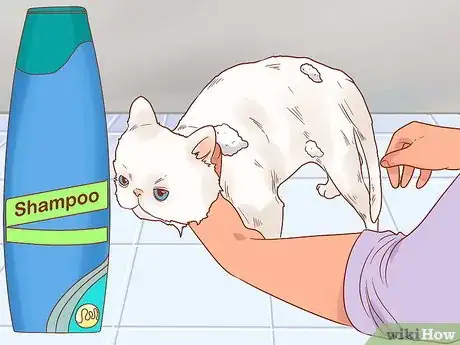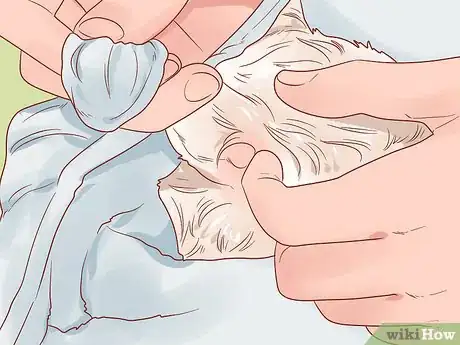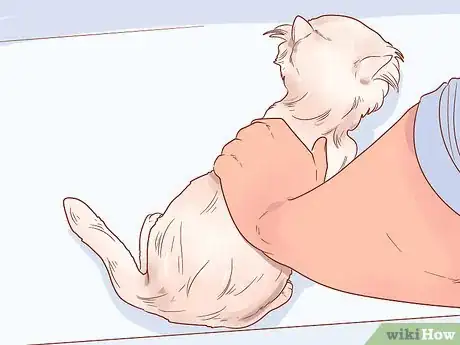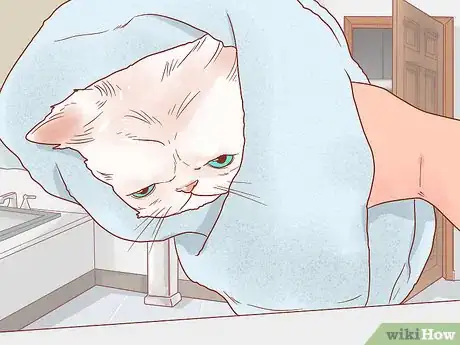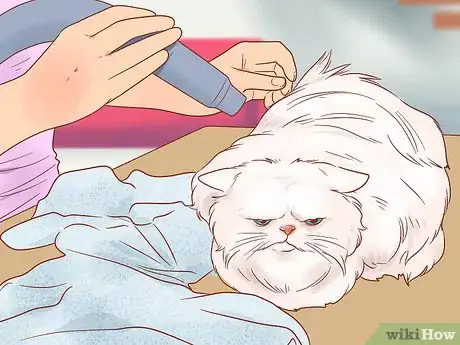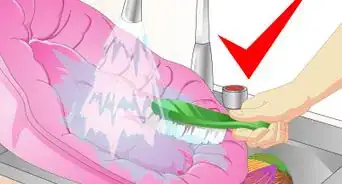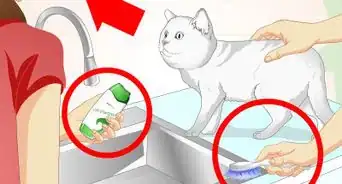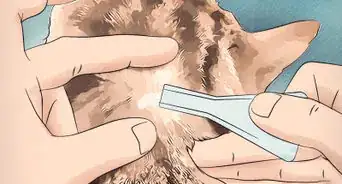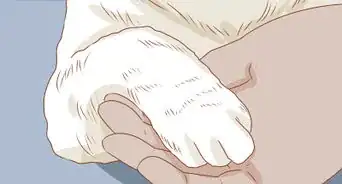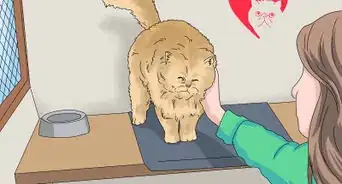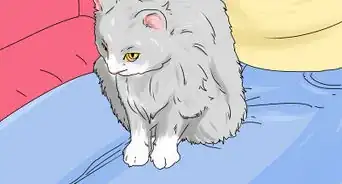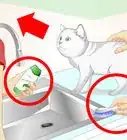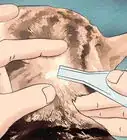This article was co-authored by Melissa Nelson, DVM, PhD. Dr. Nelson is a Veterinarian who specializes in Companion and Large Animal Medicine in Minnesota, where she has over 18 years of experience as a veterinarian in a rural clinic. She received her Doctor of Veterinary Medicine from the University of Minnesota in 1998.
wikiHow marks an article as reader-approved once it receives enough positive feedback. In this case, 89% of readers who voted found the article helpful, earning it our reader-approved status.
This article has been viewed 155,107 times.
Persian cats have beautiful long hair that requires regular maintenance. They need to be brushed and combed daily, bathed once or twice a month, and have their nails clipped every ten days to two weeks. If you're giving your cat a complete grooming in one day, it's important to follow steps in the proper order. Your first step should be clipping their claws. This will dull these “weapons” if they should fight back during their bath or blow-drying. After that, you should comb and brush your cat's fur to remove the undercoat and any matted fur. Finally, you should bathe your cat to clean and condition their fur.
Steps
Clipping Your Cat's Claws
-
1Buy clippers designed for cat's claws. Nail clippers for cats look like scissors at first glance but have a specially curved edge to accommodate feline claws. Buy them in any pet supply store. Because Persians are large cats, you might have to buy slightly larger clippers. Ask a staff member for assistance.
- Never use scissors or anything with a straight blade. This can be extremely uncomfortable, if not painful.
- Keep styptic powder on hand, just in case you accidentally clip the nail too short or if it starts bleeding.
-
2Choose the right time and place. Opt for a time when your cat is calm and relaxed. Right after a meal or before a nap is usually a good choice. Make sure the room is quiet without any distractions, such as a view of the bird feeder. If you share your home with other animals, close the door so that they can't enter.[1]Advertisement
-
3Practice before you clip. Hold your cat's paw in your hand. Do this slowly and gently. Start massaging it for one to three seconds. If your cat pulls away, don't fight them. Keep a gentle hold of the paw while allowing your cat to guide the motion. After they calm down, massage toe and give it a gentle squeeze. You will see a claw emerge. Give your cat a treat for their cooperation. Practice this on a different toe every other day until your cat gets used to it.
- Get your cat used to the sound of clippers by practicing on an uncooked piece of pasta. Sit near your cat, put the noodle in the clippers, and trim it. Let your cat sniff the clippers if they want.
- Get to the point where you can massage and gently squeeze the toe while you clip the pasta. Always reward your cat with a treat after each practice session.[2]
-
4Recognize the parts of the claw. Only clip the white part of the nail. The pink area is the quick, which contains blood vessels and nerves. Always stay away from this part of the claw. If you clip it, you can cause your cat a great deal of pain and put them at risk for an infection.
- If you accidentally cut the quick, apply styptic powder to a moistened cotton ball and hold it against the wound for 5 to 10 seconds. Buy it in any pet supply store.
-
5Clip the nails. Massage each toe until the claw emerges. Clip only the white part of the claw. If your cat seems unfazed, proceed to the next claw. Don't forget the treat after each clipping session![3]
- If the cat struggles, try asking another person to hold the cat while you clip their nails.
-
6Make nail clippings a multi-day event. This is especially helpful if your cat isn't used to having their nails clipped. Schedule clippings based on your cat's preferences. You could clip the front paws one day and the back paws the next. Alternatively, you could focus on a different paw each day.[4]
Combing and Brushing Your Cat
-
1Comb first. Use a wide-toothed metal comb. Start at the back of your cat's head and work your way to the tail. Pay attention to the armpits and the belly, where hair gets tangled easily. Move the comb with the grain of the hair. Use quick, yet gentle, strokes. This will remove excess fur and help you to detect matting.[5]
- Use caution if you decide to comb against the grain. It might help to remove the undercoat more efficiently, but it can also cause your cat great discomfort. Do this only if they don't seem to mind it. Otherwise, comb only with the grain.
-
2Comb the face. Use a fine-toothed metal comb. Comb with the grain of the hair. Be careful to avoid your cat's eyes, nose, and ears. Avoid nylon combs, which can generate static electricity and literally shock your cat.
-
3Detangle mats. Avoid pulling on tangled hair. If you find a mat, start combing in downward strokes at the bottom. Gradually work your way up as you detangle the area beneath it. If the metal comb doesn't work, try using a mat splitter, which you can buy in any pet supply store.
-
4Begin brushing. Use a brush with steel bristles to thin out the undercoat, which leaves the topcoat healthy. Start at the head and gradually move toward the tail. Move with the grain of the fur. Keep brushing your cat until the undercoat is gone. Usually you can figure this out by how much fur is on brush.
- Check the brush after a few strokes. Remove the hair from the bristles and continue brushing. Keep doing this until you pick up little to no hair. When there is hardly any fur on the brush, the undercoat is removed. Remove the undercoat every three weeks.
- As you brush the fur, check for any unusual lumps, growths, scabs, rashes, or flaky patches. If you find one, visit your vet to have it checked out.
-
5Use a child's toothbrush with soft bristles. You'll need this for brushing around your cat's eyes. Sometimes Persians get a buildup of eye secretions that can affect their field of vision. A toothbrush with soft bristles will allow you to sweep away the buildup without harming your cat's eyelids. Use quick, gentle strokes. Brush away from the eyes.[6]
-
6Use grooming clippers around the hindquarters. Persians often get feces stuck in their fur. This makes them prone to infections. Cut the fur around the back area of the legs near the anus. Repeat this process every 3 weeks.
- Avoid using scissors, which can pose a stabbing hazard.
Bathing Your Cat
-
1Bathe your cat once to twice a month. Persian cats' fur tends to get greasy, but frequent baths can remedy that. If your cat is young, start with two baths a month to get them used to the process. Afterward, depending on how oily their coat gets, you could cut back to once a month.
-
2Buy a shampoo that matches your cat's coat color. If you buy a clear shampoo for a dark-haired cat, you'll end up lightening their fur. Dark shampoos will darken the fur of a light-haired cat. When the shampoo and fur colors match, it will enrich the color of your cat's coat. Stick to shampoos specially formulated for cats, which you can buy in your local pet supply store.
- If you have a multi-colored cat, buy a shampoo that matches the dominant color in their coat. For example, you should buy a brown shampoo for a calico whose fur is mostly brown with smaller black and white patches.
- Make sure the shampoo is a tearless formula so that it won't irritate your cat's eyes when you wash their face.[7]
-
3Fill the sink or tub. Run warm water so that you don't burn or shock your cat. Turn off the tap when the water level reaches about 4 inches (10 cm). Just use water at this point. Don't worry about shampoo, conditioner, or degreaser just yet.[8]
-
4Start at the tail. This is especially important if you don't know how your cat will react to getting wet. As you wet your cat's tail, watch their reaction. If they don't seem to mind, continue to wet more of their fur.[9] If they put up a fuss, remain calm and talk to them in a soothing voice. Pet them as you wet their fur. Hold them firmly, but be careful not to hurt them.[10]
- Don't panic or get angry if your cat bites you, scratches you, or runs off. Let them stew in their anger. You can always try again tomorrow.
- It might take a while to get your cat completely wet. This is perfectly normal with thick and/or coarse hair.
-
5Watch out for facial features. Don't spray water directly into your cat's mouth, nose, or eyes. Place large cotton balls at the opening of your cat's ears. This will prevent water from getting into the ear canal.[11]
-
6Degrease your cat. Use an organic degreaser to remove excess oils from your cat's fur. Follow the instructions on the label to prevent any irritation to your cat's skin. Dilute the substance, if necessary. Then, apply it to your cat's fur. Add water, bring it to a lather, and rinse thoroughly. You can buy degreaser in pet supply stores.[12]
-
7Float the coat. This involves letting the water float the coat hair up. When this happens, it penetrates the undercoat to ensure all the shampoo is rinsed out. Gently urge your cat to place their body (except their head) under the water. Hold them in place for a minute or two. Repeat this step after shampooing and conditioning, as well.
-
8Shampoo your cat. Work the shampoo into your cat's fur. Keep it away from your cat's face to prevent irritation. Lather up the shampoo and rinse completely.[13]
-
9Clean your cat's ears. Use an ear cleaner made for pets. Do NOT use shampoo. Apply the ear rinse to the ear. Let it sit for 2-3 minutes. If you cat shakes it out, that's okay. Take a cotton ball and gently wipe the inside of the ears to remove wax and debris. Clean only the area that you can see.
- Never stick a cotton swab deep into the ear. If you need to have your cats ears cleaned more deeply, contact your vet.[14]
-
10Apply the conditioner. This will give the fur a healthy soft texture and make de-matting easier. Use a product specially formulated for Persian cats. Work the conditioner into the fur. Keep the conditioner away from the face. Rinse until the conditioner is completely washed out of the fur.[15]
-
11Wrap your cat in a towel. Use a thick, absorbing towel to soak up as much water as possible. Make sure the towel is large enough for the cat's entire body. Wrap the towel completely around their body, as if you were swaddling them. Run your hands up and down your swaddled cat to quicken the absorption process.[16]
- Don't rub the cat's fur with the towel, as this could cause the fur to get tangled.
-
12Blow dry your cat's fur. Most cats are sensitive to loud noises. If your cats hides when you vacuum, they might not like this step. Start at the tail if you've never used a hair dryer on them before. This way, they can run away without scratching you. If they don't seem to mind, gradually move the blow dryer up their body. Dry the fur as you would your own hair until it's completely dry.[17]
Expert Q&A
Did you know you can get expert answers for this article?
Unlock expert answers by supporting wikiHow
-
QuestionIs a waxy debris in and around my cat's ears normal?
 Melissa Nelson, DVM, PhDDr. Nelson is a Veterinarian who specializes in Companion and Large Animal Medicine in Minnesota, where she has over 18 years of experience as a veterinarian in a rural clinic. She received her Doctor of Veterinary Medicine from the University of Minnesota in 1998.
Melissa Nelson, DVM, PhDDr. Nelson is a Veterinarian who specializes in Companion and Large Animal Medicine in Minnesota, where she has over 18 years of experience as a veterinarian in a rural clinic. She received her Doctor of Veterinary Medicine from the University of Minnesota in 1998.
Veterinarian
Things You'll Need
- Nail clippers
- Styptic powder
- Metal combs (wide-toothed and fine-toothed)
- Steel-grade brush
- Mat splitter
- Child's toothbrush with soft bristles
- Degreaser
- Shampoo
- Conditioner
- Blow dryer
- Large bath towel
References
- ↑ https://www.aspca.org/pet-care/cat-care/cat-grooming-tips
- ↑ https://www.aspca.org/pet-care/cat-care/cat-grooming-tips
- ↑ https://www.aspca.org/pet-care/cat-care/cat-grooming-tips
- ↑ https://www.aspca.org/pet-care/cat-care/cat-grooming-tips
- ↑ https://www.youtube.com/watch?v=vFEr9uN4duU
- ↑ https://www.youtube.com/watch?v=vFEr9uN4duU
- ↑ https://pethelpful.com/cats/Bathing-Your-Cat-Without-Getting-Clawed-to-Death-Simple-Cat-Bathing-Tips
- ↑ https://pethelpful.com/cats/Bathing-Your-Cat-Without-Getting-Clawed-to-Death-Simple-Cat-Bathing-Tips
- ↑ https://www.youtube.com/watch?v=vFEr9uN4duU
- ↑ https://pethelpful.com/cats/Bathing-Your-Cat-Without-Getting-Clawed-to-Death-Simple-Cat-Bathing-Tips
- ↑ https://www.aspca.org/pet-care/cat-care/cat-grooming-tips
- ↑ https://www.youtube.com/watch?v=vFEr9uN4duU
- ↑ https://www.youtube.com/watch?v=vFEr9uN4duU
- ↑ https://www.aspca.org/pet-care/cat-care/cat-grooming-tips
- ↑ https://www.persianbc.org/grooming-white-persians.php
- ↑ https://www.youtube.com/watch?v=vFEr9uN4duU
- ↑ https://www.youtube.com/watch?v=vFEr9uN4duU
- ↑ https://www.persianbc.org/grooming-white-persians.php
- ↑ https://www.youtube.com/watch?v=vFEr9uN4duU
- ↑ https://www.pets4homes.co.uk/pet-advice/how-to-groom-a-long-haired-persian-cat.html
- ↑ https://www.aspca.org/pet-care/cat-care/cat-grooming-tips
About This Article
To groom a Persian cat, start by brushing your cat's body with a wide-toothed metal comb, paying special attention to the armpits and belly. Then, carefully comb your cat's face using a fine-toothed comb. When you're finished combing your cat, brush its body with a steel-bristled brush to thin out the undercoat, which will leave the topcoat nice and healthy. Next, brush your cat's face with a soft-bristled toothbrush, making sure you remove any buildup underneath its eyes. Finally, use clippers to cut the fur around its hindquarters. To learn how to bath your Persian cat, scroll down!
